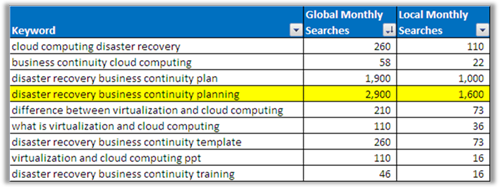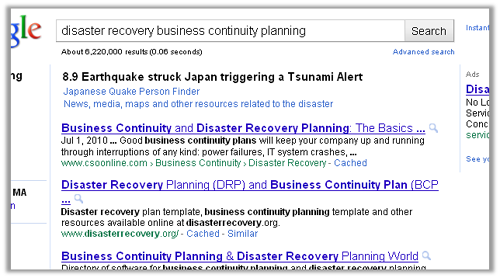3 Content Strategies To Target Decision Makers By Search Intent
One of the challenges in B2B marketing is the need to satisfy inquiries and research from multiple decision makers within an organization. Search engines are one of the first places all of these parties will go, but with different search queries in mind. This fact is something search engine marketers working with B2B organizations need […]
One of the challenges in B2B marketing is the need to satisfy inquiries and research from multiple decision makers within an organization. Search engines are one of the first places all of these parties will go, but with different search queries in mind.
This fact is something search engine marketers working with B2B organizations need to recognize, and develop keyword and copy recommendations in association to this.
Unlock The Potential Search Intent Of A Keyword Target
While keyword research is the foundation of every search engine marketing strategy, it is important to realize research goes beyond the discovery of estimated search volume.
B2B search marketers should consider three important steps following search discovery, in the keyword research process:
- The type of content that ranks well for a particular keyword query
- The type of sites that rank well for a particular keyword query
- Potential objectives the searcher may have when they perform the keyword query
In many cases, we have found that while keyword selection may be sound, the strategy for applying keywords to content might not be.
Consider this snapshot of keyword opportunities around “cloud computing”:
This snapshot presents a small range of opportunities for B2B technology marketers, whose organizations provide solutions related to the cloud computing keyword set. By digging deeper into search results (and search intent), we can create more appropriate content strategies designed to support SEO efforts.
Here are three examples of this concept in action:
Targeting Management
Using the example above, let’s assume “cloud computing benefits” is a keyword target for a search engine optimization campaign. Here is a screen grab of some of the top results for that keyword in Google.
In this case, a fair amount of article content and news releases performs well; even an article on “How to Explain Cloud Computing to Your CFO” (we’ll talk about that one in a bit…).
For organizations looking to create organic search visibility around this keyword, consideration should be made with respect to the following types of content strategies:
- White Papers
- Quality Articles & Bylines in Industry Publications
- Presentations, Webinars, or additional media assets (video perhaps?)
If the content is strong enough, wrap it around a simple landing page for registration as well. We’ve found that management will usually be willing to give a little bit of user information in exchange for a quality piece of material.
Targeting The Technologist
I’m using the term technologist as a way to cover the searcher usually tasked with implementing a B2B technology solution. As such, these individuals often have a deeper understanding of terminology, so their keyword search are more complex when finding information.
Here is a snapshot of some potential more complex keyword opportunities, based off of real search referral data in web analytics.
I’ve highlighted “disaster recovery business continuity planning” because, in my opinion, this is a pretty complex keyword that also contains significant search volume. Here is a screen grab of the current search landscape around that keyword.
Not only are all of the results research-based, but consider that three of the top ten are primary domains (two that even outrank Wikipedia). Additional factors worth considering:
- Content on secondary pages span multiple pages or collect multiple resources
- Two PDF’s rank prominently at the bottom of the page
- All of the content appears free to access
This supports the theory that this type of searcher, using more comprehensive keywords to find specific research material, also want to do review content outside of a registration form.
While the investment in this type of content may raise questions (particularly when a visible connection to lead nurturing appears absent), consider the organic link value. For the top result, I’ve found over fifty unique links, and several hundred (if not thousands of) links via scraped content as well.
TIP: Regarding “Free” Content:
Depending on your organization’s reporting tools, in coordination with traditional lead tracking, you may be able to find if out your prospects and customers are spending time reviewing this material, regardless of registration. That information is valuable and may be used as part of the conversation in sales discussions later in the process.
Targeting Executives/Leadership
The final piece to the puzzle are the C-level team members; often times a final decision maker, or at least influential in the decision making process. While many of these individuals leave the research to others, they likely want to see the brand, and the organization behind it.
This audience’s search query probably will be more high level, and brand specific.
Recommendations:
Are you dominating search engine results for your brand? Here is a chance for social media to come into play, and this is an example of one company’s brand-based search presence (for a company that also ranks #1 for “cloud server”):
But if you still weren’t thinking social media and content marketing, could have an impact on search, consider this:
According to a recent ITSMA study polling business and technology decision makers, 58% look at thought leadership as a factor in the buying decision. 71% follow discussions and threads in popular social networking sites and forums (reference)
Don’t forget about PPC as well. It may be advantageous to sponsor results around your branded search keywords, to help support company messaging, and potentially streamline the lead generation process.
Tying It Together With SEO Best Practices
Remember that we’re still tying content and keywords to an on-page/site SEO strategy. Some quick SEO best practices to keep top of mind:
- Keyword-specific HTML Titles, Meta Information
- Keyword-specific Page Headlines & sub-headlines, and copywriting
- Technical SEO structure such as keyword-friendly web addresses
- Linking strategies, via third party sites and internal cross-linking
The little details matter quite a bit, and it is easy to forget or simply ignore some of the finer points after getting through a focused round of content development. Make sure your content has everything it needs to support SEO visibility, regardless of audience.
In Summary
Keyword research goes beyond traffic volume and into the evaluation of the content that will resonate for particular keyword targets. Consider the potential decision maker in the B2B buying cycle most likely searching for that keyword as well. They will want to review different pieces of information about the organization, using different keyword strategies to find relevant information.
What sort of strategies have worked for you? I’d love to hear your thoughts and opinions via the comments below.
Contributing authors are invited to create content for Search Engine Land and are chosen for their expertise and contribution to the search community. Our contributors work under the oversight of the editorial staff and contributions are checked for quality and relevance to our readers. The opinions they express are their own.
Related stories




